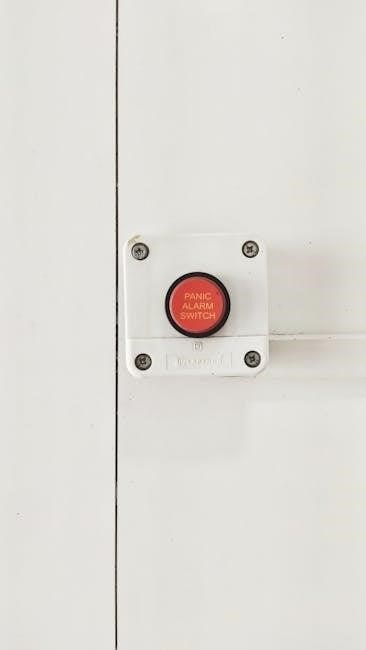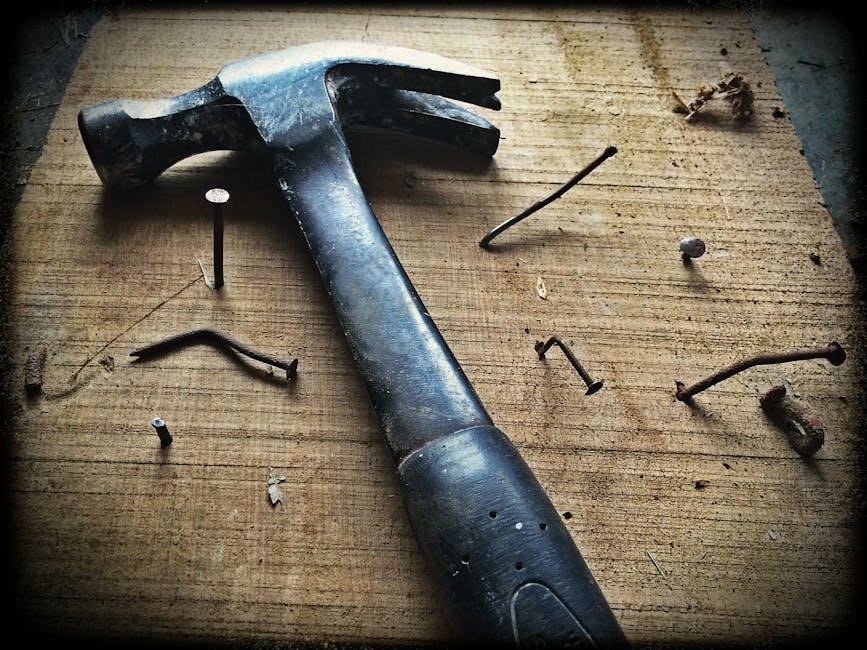first alert smoke carbon monoxide alarm manual
Welcome to the First Alert Smoke & Carbon Monoxide Alarm Manual‚ your essential guide to understanding and installing these life-saving devices for enhanced home safety.
Key Features of the First Alert Smoke & Carbon Monoxide Alarm
The First Alert Smoke & Carbon Monoxide Alarm combines advanced detection technology for both smoke and CO threats. It features a photoelectric smoke sensor for accurate fire detection and a CO sensor to monitor dangerous gas levels. The alarm is UL217 certified‚ ensuring reliability and compliance with safety standards. Additional features include a battery backup‚ silence button to mute false alarms‚ and latching alarm functionality to identify which unit triggered the alert. Smart models offer app connectivity‚ sending notifications to your smartphone for remote monitoring. These features ensure comprehensive protection and peace of mind for your home and family.
Importance of Reading the Manual
Reading the First Alert Smoke & Carbon Monoxide Alarm manual is crucial for ensuring proper installation‚ operation‚ and maintenance of the device. The manual provides essential safety information‚ operational guidelines‚ and troubleshooting tips to maximize the alarm’s effectiveness. It details how to interpret alarm signals‚ perform routine tests‚ and replace batteries or components. Understanding the manual helps users recognize potential hazards and take appropriate actions to protect their homes and families. Failure to follow the instructions may lead to improper functionality‚ reducing the alarm’s ability to detect threats. Always keep the manual handy for reference to ensure optimal performance and compliance with safety standards.
What is Covered in This Manual
This manual provides comprehensive guidance on the First Alert Smoke & Carbon Monoxide Alarm‚ including installation‚ maintenance‚ and troubleshooting. It details key features‚ optimal placement‚ and step-by-step instructions for setup. The manual also covers battery replacement‚ testing procedures‚ and error resolution. Additionally‚ it explains the differences between photoelectric and ionization sensors‚ ensuring users understand how each type detects threats. Safety tips and compliance with standards like UL217 are emphasized‚ along with warranty information and support contact details. This resource ensures users are fully informed to maximize their safety and the alarm’s reliability.

Installation and Placement Guidelines
Install alarms on each level and in every bedroom‚ avoiding kitchens and bathrooms. Place within 3 feet of peak on ceilings and comply with UL217 standards.
Step-by-Step Installation Process
Choose locations on each level and in every bedroom for optimal coverage. Avoid installing near kitchens or bathrooms to reduce false alarms.
For ceiling installations‚ place the alarm within 3 feet of the peak. On walls‚ mount 12 inches from the ceiling.
Use the provided mounting bracket and screws to secure the alarm firmly. Ensure it is level for proper functioning.
Connect the battery or hardwire‚ depending on your model. Tighten all connections to prevent loose wiring.
Test the alarm by pressing the test button until it sounds. This ensures it is working correctly.
Finalize by syncing with smart features if applicable‚ using the First Alert app for remote monitoring.
Follow these steps to ensure your alarm is installed safely and effectively for maximum protection.
Optimal Placement Locations for the Alarm
Proper placement of your First Alert Smoke & Carbon Monoxide Alarm is crucial for reliable detection. Install at least one alarm on every level of your home and inside each bedroom. For optimal coverage‚ place alarms near sleeping areas and in living spaces. On peaked or cathedral ceilings‚ install within 3 feet of the peak. Avoid areas near kitchens‚ bathrooms‚ or cooking appliances to minimize false alarms. Use additional alarms in large homes or those with unique layouts. Ensure compliance with local fire codes and safety standards for maximum protection.
Mounting the Alarm on Walls or Ceilings
To ensure reliable detection‚ mount your First Alert Smoke & Carbon Monoxide Alarm securely on walls or ceilings. Use the provided screws or clips to attach the mounting bracket‚ typically within 12 inches of the ceiling. For peaked or cathedral ceilings‚ install within 3 feet of the peak. Ensure the alarm is level and firmly secured. Avoid mounting near vents‚ doors‚ or windows to prevent false alarms. Always follow the manufacturer’s instructions for proper installation. Proper mounting ensures accurate detection and optimal performance of your safety device. This step is critical for your home’s fire and CO safety system.

Maintenance and Upkeep
Regular maintenance ensures your First Alert Smoke & Carbon Monoxide Alarm functions optimally. Clean the sensor with a vacuum‚ test monthly‚ and replace batteries as needed. Always follow the manual’s guidelines for troubleshooting and upkeep to maintain reliability and safety. Proper care extends the life of your device and ensures consistent protection for your home and family. Stay proactive with routine checks to avoid false alarms and potential hazards. This ensures your alarm remains a trusted safeguard against fire and CO threats.
Regular Cleaning of the Alarm
Regular cleaning is crucial for maintaining the efficiency of your First Alert Smoke & Carbon Monoxide Alarm. Use a soft‚ dry cloth or vacuum cleaner to gently remove dust and debris from the exterior and sensor. Avoid using chemicals‚ water‚ or abrasive materials‚ as they may damage the unit. Clean the alarm every 30 days to ensure optimal performance. For models with removable covers‚ take them off and wipe with a dry cloth. Testing the alarm after cleaning ensures it functions correctly. Regular maintenance prevents false alarms and guarantees reliable detection of smoke and carbon monoxide. Always follow the manual’s cleaning guidelines for best results. Regular upkeep ensures your safety and the longevity of the device. By keeping the alarm clean‚ you maintain its ability to detect threats accurately. This simple step is vital for protecting your home and family. Cleaning is a key part of routine maintenance and should be done consistently to avoid malfunctions. Refer to the manual for specific instructions tailored to your model. Proper cleaning ensures your alarm remains a dependable safeguard against fire and carbon monoxide risks. Make it a habit to inspect and clean the device regularly to uphold its effectiveness. Regular cleaning is essential for maintaining the alarm’s sensitivity and reliability. By following these steps‚ you ensure your home stays protected. Cleaning is a simple yet critical task for maintaining your smoke and carbon monoxide alarm. Regular upkeep ensures your safety and the longevity of the device. By keeping the alarm clean‚ you maintain its ability to detect threats accurately. This simple step is vital for protecting your home and family. Cleaning is a key part of routine maintenance and should be done consistently to avoid malfunctions. Refer to the manual for specific instructions tailored to your model. Proper cleaning ensures your alarm remains a dependable safeguard against fire and carbon monoxide risks. Make it a habit to inspect and clean the device regularly to uphold its effectiveness. Regular cleaning is essential for maintaining the alarm’s sensitivity and reliability. By following these steps‚ you ensure your home stays protected. Cleaning is a simple yet critical task for maintaining your smoke and carbon monoxide alarm. Regular upkeep ensures your safety and the longevity of the device. By keeping the alarm clean‚ you maintain its ability to detect threats accurately. This simple step is vital for protecting your home and family. Cleaning is a key part of routine maintenance and should be done consistently to avoid malfunctions. Refer to the manual for specific instructions tailored to your model. Proper cleaning ensures your alarm remains a dependable safeguard against fire and carbon monoxide risks. Make it a habit to inspect and clean the device regularly to uphold its effectiveness. Regular cleaning is essential for maintaining the alarm’s sensitivity and reliability. By following these steps‚ you ensure your home stays protected. Cleaning is a simple yet critical task for maintaining your smoke and carbon monoxide alarm. Regular upkeep ensures your safety and the longevity of the device. By keeping the alarm clean‚ you maintain its ability to detect threats accurately. This simple step is vital for protecting your home and family. Cleaning is a key part of routine maintenance and should be done consistently to avoid malfunctions. Refer to the manual for specific instructions tailored to your model. Proper cleaning ensures your alarm remains a dependable safeguard against fire and carbon monoxide risks. Make it a habit to inspect and clean the device regularly to uphold its effectiveness. Regular cleaning is essential for maintaining the alarm’s sensitivity and reliability. By following these steps‚ you ensure your home stays protected. Cleaning is a simple yet critical task for maintaining your smoke and carbon monoxide alarm. Regular upkeep ensures your safety and the longevity of the device. By keeping the alarm clean‚ you maintain its ability to detect threats accurately. This simple step is vital for protecting your home and family. Cleaning is a key part of routine maintenance and should be done consistently to avoid malfunctions. Refer to the manual for specific instructions tailored to your model. Proper cleaning ensures your alarm remains a dependable safeguard against fire and carbon monoxide risks. Make it a habit to inspect and clean the device regularly to uphold its effectiveness. Regular cleaning is essential for maintaining the alarm’s sensitivity and reliability. By following these steps‚ you ensure your home stays protected. Cleaning is a simple yet critical task for maintaining your smoke and carbon monoxide alarm. Regular upkeep ensures your safety and the longevity of the device. By keeping the alarm clean‚ you maintain its ability to detect threats accurately. This simple step is vital for protecting your home and family. Cleaning is a key part of routine maintenance and should be done consistently to avoid malfunctions. Refer to the manual for specific instructions tailored to your model. Proper cleaning ensures your alarm remains a dependable safeguard against fire and carbon monoxide risks. Make it a habit to inspect and clean the device regularly to uphold its effectiveness. Regular cleaning is essential for maintaining the alarm’s sensitivity and reliability. By following these steps‚ you ensure your home stays protected. Cleaning is a simple yet critical task for maintaining your smoke and carbon monoxide alarm. Regular upkeep ensures your safety and the longevity of the device. By keeping the alarm clean‚ you maintain its ability to detect threats accurately. This simple step is vital for protecting your home and family. Cleaning is a key part of routine maintenance and should be done consistently to avoid malfunctions. Refer to the manual for specific instructions tailored to your model. Proper cleaning ensures your alarm remains a dependable safeguard against fire and carbon monoxide risks. Make it a habit to inspect and clean the device regularly to uphold its effectiveness. Regular cleaning is essential for maintaining the alarm’s sensitivity and reliability. By following these steps‚ you ensure your home stays protected. Cleaning is a simple yet critical task for maintaining your smoke and carbon monoxide alarm. Regular upkeep ensures your safety and the longevity of the device. By keeping the alarm clean‚ you maintain its ability to detect threats accurately. This simple step is vital for protecting your home and family. Cleaning is a key part of routine maintenance and should be done consistently to avoid malfunctions. Refer to the manual for specific instructions tailored to your model. Proper cleaning ensures your alarm remains a dependable safeguard against fire and carbon monoxide risks. Make it a habit to inspect and clean the device regularly to uphold its effectiveness. Regular cleaning is essential for maintaining the alarm’s sensitivity and reliability. By following these steps‚ you ensure your home stays protected. Cleaning is a simple yet critical task for maintaining your smoke and carbon monoxide alarm. Regular upkeep ensures your safety and the longevity of the device. By keeping the alarm clean‚ you maintain its ability to detect threats accurately. This simple step is vital for protecting your home and family. Cleaning is a key part of routine maintenance and should be done consistently to avoid malfunctions. Refer to the manual for specific instructions tailored to your model. Proper cleaning ensures your alarm remains a dependable safeguard against fire and carbon monoxide risks. Make it a habit to inspect and clean the device regularly to uphold its effectiveness. Regular cleaning is essential for maintaining the alarm’s sensitivity and reliability. By following these steps‚ you ensure your home stays protected.
Battery Replacement and Care
Proper battery maintenance is essential for your First Alert Smoke & Carbon Monoxide Alarm. Replace batteries annually or when the low-battery alert sounds. Use high-quality alkaline batteries for optimal performance. For battery-powered models‚ turn off the alarm and remove the battery compartment. Insert new batteries following the polarity markings. Avoid mixing old and new batteries or using rechargeable types. After replacement‚ test the alarm to ensure it functions correctly. Regular battery care ensures continuous protection and prevents false alarms. Always dispose of old batteries responsibly. Refer to your manual for specific instructions tailored to your model. Proper battery maintenance guarantees reliable safety and functionality.
Testing the Alarm for Proper Functionality
Regular testing ensures your First Alert Smoke & Carbon Monoxide Alarm operates correctly. Press and hold the test button to activate the alarm. Verify the siren sounds and the LED light flashes. For smart models‚ check notifications on your smartphone. Test the alarm monthly and after battery replacement. Use the test button or follow app instructions for smart devices. Ensure no obstructions block the sensor. Clean the alarm if necessary to avoid false readings. Testing confirms the alarm detects smoke and CO accurately‚ providing reliable protection for your home and family. Always follow the manual for specific testing instructions.

Troubleshooting Common Issues
Welcome to the troubleshooting section of the First Alert Smoke & Carbon Monoxide Alarm manual. Address common issues like false alarms‚ error lights‚ or connectivity problems here.
Resolving False Alarms
False alarms can occur due to dust‚ steam‚ or cooking fumes. To resolve this‚ press the test/silence button to temporarily mute the alarm. Ensure the device is clean by vacuuming the cover. Relocate the alarm away from kitchens or bathrooms to minimize interference. Check for proper installation and ensure the alarm is not near direct airflow vents. If issues persist‚ replace the battery or reset the device. Always refer to the manual for specific troubleshooting steps to maintain accurate detection and safety.
Addressing Error Lights or Sounds
Error lights or sounds on your First Alert Smoke & Carbon Monoxide Alarm indicate potential issues. A steady red light or chirping noise often signals a low battery or malfunction. Check the alarm’s power source and ensure it is properly connected. Clean the sensor to remove dust or debris that may trigger errors. If the issue persists‚ replace the battery or reset the device. Refer to the manual for specific light patterns and their meanings. Addressing these issues promptly ensures your alarm functions correctly and provides reliable protection for your home and family.
Fixing Connectivity Issues with Smart Features
If your First Alert Smoke & Carbon Monoxide Alarm experiences connectivity issues with its smart features‚ ensure it is properly connected to your Wi-Fi network. Check your router and internet connection for stability. Reset the alarm by removing the battery or unplugging it‚ then reconnecting. Open the First Alert app‚ ensure it is updated‚ and follow prompts to re-establish connectivity. If issues persist‚ restart your router or reinstall the app. Connectivity is crucial for remote alerts and monitoring‚ so resolving these issues ensures your safety features function optimally.

Safety Tips and Best Practices
Ensure safety by installing alarms near bedrooms and testing them monthly. Replace alarms every 10 years and never ignore alerts. Understand carbon monoxide risks and have an escape plan ready.
Understanding Carbon Monoxide Risks
Carbon monoxide (CO) is a silent killer‚ an odorless‚ colorless gas produced by incomplete combustion from sources like heaters‚ cars‚ and generators. Prolonged exposure can cause dizziness‚ nausea‚ and even death. CO alarms are crucial as they detect harmful levels early‚ providing time to evacuate. Install alarms near bedrooms and on every level of your home. Replace CO alarms every 7 years and never ignore alerts. Stay safe by understanding CO risks and having an escape plan ready. Early detection is key to preventing tragedies. Always follow local fire codes for compliance.
Fire Prevention and Early Warning Signs
Fire prevention is crucial for safeguarding your home and family. Smoke alarms detect particles of combustion‚ providing early warning signs of a fire. Install smoke alarms on every level of your home and inside each bedroom for maximum protection. Test alarms monthly and replace batteries annually. Never ignore a smoke alarm‚ as it may indicate a dangerous situation. Fires spread quickly‚ so having a plan for evacuation is vital. Stay alert to signs like unusual odors or visible smoke‚ and take immediate action to ensure safety. Early detection saves lives and prevents property damage.

When to Replace the Alarm
Smoke alarms should be replaced every 10 years‚ while carbon monoxide alarms typically need replacement every 7 years. Replace the alarm immediately if it shows signs of wear‚ such as chirping sounds‚ dimmed lights‚ or failure to detect smoke or CO during tests. Always follow the manufacturer’s guidelines for replacement to ensure optimal performance. Properly dispose of old alarms and recycle batteries when possible. Regular replacement is critical for maintaining reliable fire and CO detection‚ protecting your home and family from potential threats. Stay proactive to ensure your safety systems remain effective.

Understanding the Alarm Types
Photoelectric sensors detect smoldering fires‚ while ionization sensors respond to flaming fires. Both types ensure comprehensive detection of smoke particles for reliable home safety and early alerts.
Photoelectric vs. Ionization Smoke Sensors
Understanding the difference between photoelectric and ionization smoke sensors is crucial for effective fire safety. Photoelectric sensors use a light beam to detect smoke particles‚ making them ideal for smoldering fires and reducing false alarms from cooking or steam. Ionization sensors‚ on the other hand‚ detect changes in airflow caused by smoke particles‚ offering quick response to fast-spreading‚ flaming fires. Both technologies ensure reliable smoke detection‚ but photoelectric sensors are known for fewer nuisance alarms. For comprehensive protection‚ many alarms combine both technologies to maximize safety and minimize false alerts.
How Carbon Monoxide Sensors Work
Carbon monoxide (CO) sensors detect the presence of this odorless‚ colorless gas through advanced technologies like electrochemical sensors or biomimetic sensors. These sensors monitor air quality and trigger alarms when CO levels exceed safe thresholds. Electrochemical sensors use a chemical reaction to identify CO molecules‚ while biomimetic sensors mimic human responses to CO exposure. Both types ensure early detection‚ providing critical time to evacuate. Proper placement and regular maintenance are essential for optimal performance‚ as CO sensors are a vital component in preventing carbon monoxide poisoning and ensuring home safety.

Smart Features and Connectivity
First Alert alarms offer smart connectivity via the First Alert app‚ enabling remote monitoring‚ customizable notifications‚ and seamless integration with smart home systems for enhanced safety.
Connecting the Alarm to the First Alert App
To connect your First Alert smoke and carbon monoxide alarm to the First Alert app‚ start by downloading and installing the app from your device’s app store. Open the app and create an account or log in if you already have one. Navigate to the “Add Device” or “Connect Alarm” section within the app. Ensure your alarm is powered on and in pairing mode—this may require pressing and holding a button until indicator lights flash. Select the alarm from the list of available devices in the app and follow the prompts to complete the connection. Once connected‚ you can customize settings‚ receive notifications‚ and monitor your home’s safety remotely.
Receiving Alerts on Your Smartphone
With the First Alert app‚ you can receive real-time alerts on your smartphone whenever smoke or carbon monoxide is detected. Once your alarm is connected to the app‚ notifications will be sent directly to your device‚ ensuring you stay informed even when you’re not at home. Alerts include details about the type of detection and the location of the alarm within your home. Customize notification settings to reduce false alarms and ensure critical alerts are prioritized. This feature provides peace of mind and allows for quick action to address potential threats‚ enhancing your home’s safety and security.

Compliance and Regulations
First Alert smoke and carbon monoxide alarms comply with UL217 standards and local fire codes‚ ensuring adherence to safety regulations for reliable protection and user trust.
Meeting UL217 Standards
First Alert smoke and carbon monoxide alarms are designed to meet UL217 standards‚ ensuring reliable detection of smoke and carbon monoxide. These standards require alarms to detect combustion particles effectively‚ providing early warnings in various conditions. Compliance with UL217 guarantees that the devices function optimally‚ offering homeowners peace of mind. Regular testing and maintenance‚ as outlined in the manual‚ help maintain compliance and ensure the alarm’s performance. By adhering to these rigorous standards‚ First Alert alarms deliver trusted protection for families and properties.
Ensuring Compliance with Local Fire Codes
First Alert smoke and carbon monoxide alarms are designed to meet or exceed local fire codes‚ ensuring they align with regional safety regulations. Proper installation and placement‚ as outlined in the manual‚ are critical for compliance. This includes positioning alarms on every level of the home and in each bedroom‚ as well as maintaining required distances from cooking appliances and heating vents. Regular maintenance‚ such as battery replacement and functionality testing‚ further supports adherence to these codes.
By following the manual’s guidelines‚ homeowners can ensure their alarms meet local fire safety standards‚ providing reliable protection for their families and properties. Always verify specific requirements with local authorities to guarantee full compliance.

Warranty and Support Information
First Alert alarms are backed by a comprehensive warranty and dedicated customer support. For assistance‚ contact First Alert at 1-800-323-9005 or visit their official website.
Understanding the Warranty Coverage
The First Alert Smoke & Carbon Monoxide Alarm is backed by a limited warranty that covers defects in materials and workmanship. The warranty period varies by model‚ typically ranging from 5 to 10 years. For specific details‚ refer to your product’s warranty documentation. The warranty does not cover damage caused by misuse‚ tampering‚ or normal wear and tear. To ensure coverage‚ register your product and retain the purchase receipt. For warranty claims or support‚ contact First Alert customer service at 1-800-323-9005 or visit their official website.
How to Contact First Alert Support
For assistance with your First Alert Smoke & Carbon Monoxide Alarm‚ contact their dedicated support team. Call toll-free at 1-800-323-9005 for troubleshooting‚ warranty inquiries‚ or product-related questions. You can also visit their official website at firstalert.com for comprehensive resources‚ including manuals‚ FAQs‚ and contact forms. Ensure to have your product model number ready for efficient support. Their customer service is available to address concerns and provide guidance‚ ensuring optimal use and safety of your alarm system.
Summarizing Key Points
This manual provides comprehensive guidance for the First Alert Smoke & Carbon Monoxide Alarm‚ ensuring proper installation‚ maintenance‚ and understanding of its features. Key points include the importance of regular testing‚ battery replacement‚ and cleaning to maintain functionality. Understanding the differences between photoelectric and ionization sensors‚ as well as carbon monoxide detection‚ is crucial for effective use. Compliance with UL217 standards and local fire codes ensures reliability. By following the manual‚ users can maximize safety and enjoy peace of mind knowing their home is protected from fire and carbon monoxide threats.
Encouraging Proper Usage for Maximum Safety
Proper usage of the First Alert Smoke & Carbon Monoxide Alarm is vital for ensuring maximum safety. Always follow the manual’s installation and maintenance guidelines to guarantee reliable performance. Regularly test the alarm‚ replace batteries as needed‚ and clean the device to prevent false alarms. Understanding the difference between smoke and carbon monoxide detection helps tailor your safety plan. By adhering to the manual’s instructions‚ you can trust the alarm to provide early warnings‚ protecting your family and home from potential threats. Consistent upkeep and awareness are key to maximizing the alarm’s effectiveness and ensuring long-term safety.










Leave a Comment